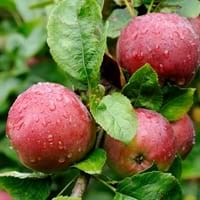Life Span
Perennial
Perennial
Origin
Eastern Europe, Southern Europe, Russia/Siberia, Southern Asia, Western Asia
Southeastern United States, North-Central United States, Central United States, South-Central United States, Southwestern United States, Texas, Canada, Mexico
Types
not available
Not Available
Habitat
Not Available
Dry areas, Prairies, Rocky areas, rocky outcrops
USDA Hardiness Zone
3-8
3-10
Sunset Zone
6, 7, 8, 9, 14, 15, 16
A1, A2, A3, H1, H2, 1a, 1b, 2a, 2b, 3a, 3b, 4, 5, 6, 7, 8, 9, 10, 11, 12, 13, 14, 15, 16, 17, 18, 19, 20, 21, 22, 23, 24
Habit
Oval or Rounded
Upright/Erect
Flower Color
White, Pink, Rose
Yellow, Purple, Burgundy, Light Green, Brown
Flower Color Modifier
Bicolor
Bicolor
Fruit Color
Yellow, Red, Green, Gold, Pink, Dark Red
Brown
Leaf Color in Spring
Green
Light Green, Gray Green
Leaf Color in Summer
Green
Light Green, Gray Green
Leaf Color in Fall
Green, Light Yellow, Brown
Light Green, Gray Green
Leaf Color in Winter
Light Green
Light Green
Leaf Shape
Ovate
Subulate
Plant Season
Spring, Fall
Summer
Sunlight
Full Sun, Partial Sun, Partial shade
Full Sun
Type of Soil
Clay, Loam, Sand
Loam, Sand
The pH of Soil
Acidic, Neutral
Neutral
Soil Drainage
Well drained
Well drained
Bloom Time
Early Spring, Spring
Late Spring, Early Summer, Summer, Late Summer
Tolerances
Drought
Drought
Where to Plant?
Ground
Ground
How to Plant?
Budding, Grafting
Seedlings
Plant Maintenance
Medium
Medium
Watering Requirements
Requires regular watering
Average Water Needs, Water in morning to avoid prompting diseases
In Summer
Lots of watering
Lots of watering
In Spring
Moderate
Moderate
In Winter
Average Water
Average Water
Soil pH
Acidic, Neutral
Neutral
Soil Type
Clay, Loam, Sand
Loam, Sand
Soil Drainage Capacity
Well drained
Well drained
Sun Exposure
Full Sun, Partial Sun, Partial shade
Full Sun
Pruning
Remove damaged leaves, Remove dead branches, Remove dead leaves
Cut or pinch the stems, Pinch Tips, Remove damaged leaves, Remove dead branches, Remove dead flowers, Remove dead leaves, Remove dead or diseased plant parts, Remove deadheads
Fertilizers
Requires high amount of nitrogen
All-Purpose Liquid Fertilizer, Apply N-P-K
Pests and Diseases
Aphids, codling moth, mussel scale, Red spider mite, woolly aphid
Pests and diseases free, Red blotch
Plant Tolerance
Drought
Drought, Dry Conditions, Dry soil, Full Sun
Flower Petal Number
Single
Single
Foliage Texture
Medium
Fine
Foliage Sheen
Matte
Matte
Attracts
Not Available
Birds, Butterflies
Allergy
Not Available
Rhinitis
Aesthetic Uses
Showy Purposes
Borders
Beauty Benefits
Not Available
Not Available
Environmental Uses
Air purification
Air purification
Medicinal Uses
Alzheimer’s Disease, bowel syndrome, Cancer, constipation, Detoxifies lever, Diabetes, Diarrhea, gallstones, Healthy teeth, hemorrhoids, High cholestrol, Immunity, Improve heart health, Parkinson
Analgesic
Part of Plant Used
Fruits, Leaves
Flowers
Other Uses
Used As Food, Used for its medicinal properties
Can be made into a herbal tea, Used in making tea
Used As Indoor Plant
No
No
Used As Outdoor Plant
Yes
Yes
Garden Design
Edible, Feature Plant, Fruit / Fruit Tree
Container, Cutflower, Mixed Border, Wildflower
Botanical Name
MALUS domestica 'Royal Gala'
RATIBIDA columnifera
Common Name
Apple, Eating Apple, Royal Gala Apple
Mexican Hat
In Hindi
Royal Gala Apple
Mexican Hat
In German
Royal Gala Apfel
Mexican Hat
In French
Royal Gala d'Apple
Mexican Hat
In Spanish
Manzana Royal Gala
mexican Hat
In Greek
Royal Gala της Apple
Mexican Hat
In Portuguese
Maçã Royal Gala
Mexican Hat
In Polish
Royal Gala jabłko
Mexican Hat
In Latin
Regia Schola Apple
Mexicanus Hat
Phylum
Magnoliophyta
Tracheophyta
Class
Eudicotyledones
Magnoliopsida
Family
Rosaceae
Asteraceae
Genus
Not Available
Ratibida
Clade
Not Available
Angiosperms, Asterids, Eudicots
Tribe
Not Available
Not Available
Subfamily
Not Available
Not Available
Number of Species
Not Available
Not Available
Importance of Royal Gala Apple and Mexican Hat
Want to have the most appropriate plant for your garden? You might want to know the importance of Royal Gala Apple and Mexican Hat. Basically, these two plants vary in many aspects. Compare Royal Gala Apple and Mexican Hat as they differ in many characteristics such as their life, care, benefits, facts, etc. Every gardener must at least have the slightest clue about the plants he wants to plant in his garden. Compare their benefits, which differ in many ways like facts and uses. The medicinal use of Royal Gala Apple is Alzheimer’s Disease, bowel syndrome, Cancer, constipation, Detoxifies lever, Diabetes, Diarrhea, gallstones, Healthy teeth, hemorrhoids, High cholestrol, Immunity, Improve heart health and Parkinson whereas of Mexican Hat is Analgesic. Royal Gala Apple has beauty benefits as follows: Not Available while Mexican Hat has beauty benefits as follows: Not Available.
Compare Facts of Royal Gala Apple vs Mexican Hat
How to choose the best garden plant for your garden depending upon its facts? Here garden plant comparison will help you to solve this query. Compare the facts of Royal Gala Apple vs Mexican Hat and know which one to choose. As garden plants have benefits and other uses, allergy is also a major drawback of plants for some people. Allergic reactions of Royal Gala Apple are Not Available whereas of Mexican Hat have Rhinitis respectively. Having a fruit bearing plant in your garden can be a plus point of your garden. Royal Gala Apple has showy fruits and Mexican Hat has no showy fruits. Also Royal Gala Apple is not flowering and Mexican Hat is not flowering . You can compare Royal Gala Apple and Mexican Hat facts and facts of other plants too.





